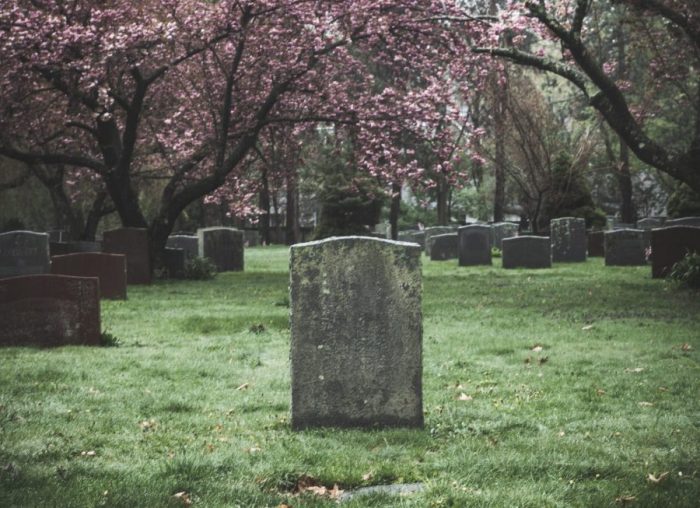Gravestone Symbols And Their Meaning

Gravestone Symbolism
When doing ancestor research, visiting a cemetery may be a haunting, yet thoughtful experience. Gravestones frequently have other, more symbolic inscriptions on them besides names, dates of birth and death. They all typically signify something, maybe a quality that person possessed, a principle they upheld, or a reference to their religious beliefs.
In this article we’re looking into some of the most popular symbols on gravestones and the meaning behind them. That said, you may find different interpretations of certain symbols due to how varied their purpose is in different cultures..
Types Of Gravestone Symbols:
Flowers and Plants

One of the most requested gravestone symbols to carve are flowers.Sometimes a flower is picked out for its purely aesthetic appeal, but more often than not people choose this or that flower based on their unique symbol gravestone emblems’ meaning.
The narcissus or daffodil may represent rebirth and resurrection. Depending on what culture you look at, it can be the flower of paradise or the underworld. The Christians focused on the victory of divine love and sacrifice over vices, and ultimately over death, whereas in Greek mythology it could have had a negative symbolic meaning (vanity and self-love).
Children’s gravestone symbols frequently include dandelions. The dandelion has represented both love and grief since Victorian times, whilst also serving as a metaphor for how fleeting life is.
Since the 12th century, the virgin Mary’s purity, and chastity have been represented by the white lily, which has significant symbolic importance in Christianity. Meanwhile, in Chinese culture the lily is symbolic of feminine beauty; the lily has also been referred to as eternal, incorruptible, and the pinnacle of human meditation.
The rose represents love in all of its heavenly and earthly tones. When placed on a gravestone, the rose can symbolize strong affectionate feelings towards the deceased as well as a strong yearning.
The sunflower often represents loyalty to the Catholic Church. Although sunflowers always face the sun when they are young, when they are fully grown, they always face the east, which is the same way that Christian cemeteries are oriented: toward the rising sun.
Religious Symbols

With many religions focusing a lot on life after death, it’s no surprise that some of the most tombstone symbols are of theistic nature.
Some of the most typical religious symbols found in cemeteries are angels. They are carved into tombstones and stand atop them like sculptures. Angels symbolize a belief that a person has entered paradise after passing away. Some angels are sobbing, their wings drooping in sorrow, expressing their mourning, while others are mid-flight, sounding a trumpet.
Crosses can generate many symbol gravestone emblems’ messages ranging from love, faith and goodness to terror and fear, however in the case of cemeteries, they’re largely supposed to represent holiness and peace. You may find such crosses as the Botonee Cross, the Celtic Cross, the Eastern Cross, the Ionic Cross, the Latin Cross and many others.
The open book can represent the Bible, or the Book of Life, which refers to a biblical passage in Revelation that states that only the dead whose names are contained therein will receive entrance into heaven. Blank pages might also signify an unfinished story or a life that was taken too soon.
Hands also make many appearances as symbols for gravestones in many shapes and forms. One hand would normally symbolize the hand of God, two praying hands would mean strong devotion to the church, while a rather peculiar configuration of two hands with the four fingers on each hand positioned as two sets of two fingers can tell us that the deceased was a Jewish Priest.
The harp is an important musical instrument in Christianity, associated with David of the Old Testament; the patron saint of musicians. It’s also very symbolic of strong hope, devotion and praise to God.
Animals

Depictions of animals as symbol gravestone emblems are also very common. In many cultures, animals represent certain life events or processes as well as people’s personal qualities or characteristics.
The dove plays a significant role in Christian animal symbolism, representing the Holy Spirit. A reference to the white dove appears in the account of Christ’s baptism: “And straightway coming up out of the water, he saw the heavens opened, and the Spirit like a dove descending upon him.” (Mark 1:10). The dove is also seen as a peace symbol in Judaism.
The lion represents the might of God and protects the grave from evil spirits. The lion’s watch is supposed to be as timeless as the stone on which it is carved. The lion also commemorates the tenacity and bravery of the souls they guard.
The butterfly is the symbol of resurrection. Just like caterpillars turn into magnificent creatures that launch into flight, the souls of the deceased will ultimately rise from the grave, turning into a new being.
The lamb is a common symbol on children’s gravestones, representing innocence and purity. So if you see a gravestone in one of your ancestor’s family plots with a lamb, you could safely assume that it is the final resting place for an infant or child.
Military Symbols
One particular kind of symbol gravestone emblems is the one that is tied to military service. Clues that your ancestor served in the military may be seen right on the gravestone itself or on military flag holders placed next to the gravestone. Also, military flag holders are unique for each war and very often specific to various branches of service or even locations and regiments. Once you have found military-related information at your ancestor’s gravesite, be sure to do some follow-up research by checking out military records.
Conclusion
A walk in the cemetery is indeed an experience that not all people enjoy, however, one cannot deny that a person’s gravestone can be an invaluable source of information when conducting ancestry research. Merely by looking at the burial site we are able to identify the biographical facts, personal qualities and spiritual beliefs of the deceased. And, at the end of the day, it rarely hurts to pay respects to our ancestors one more time for as long as they live in our memory, they will live forever.





